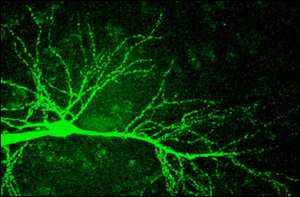


David Whitehouse, PhD
BBC News Online Science Editor
Scientists have managed to photograph what happens to the brain during learning and recalling memory.
The observations detail some of the changes that occur to arrangements of nerve cells that take place when a memory is laid down. Exactly how these changes relate to the memory of specific things such as faces and events is an entirely different and as yet unknown matter.
Researchers at the University of Geneva used an electron microscope to photograph the changes occurring at the connection points between two nerve cells when long-term memory is established.
Looking at cross-sections of rat brains, the research team constructed three-dimensional images of minuscule nerve cell connections. In doing so, they saw that the memory process occurs in the duplication of certain connections or synapses between nerve cells.
The images, featured in the journal Nature, have been hailed as a breakthrough in the understanding of how the brain works.
It has been known for some time that the brain of a young rat raised in a stimulating environment possesses a network of neurons much more complex than the brain of a rat that has been under-stimulated.
But until now, the detailed effect of this stimulation on nerve cells had never been seen.
Neurobiologists call the process "Long-Term Potentiation" (LTP) when a nerve cell is stimulated by a neighbouring cell and acts as if it "remembers" the stimulation. It is this change that acts as the fundamental storage for memory information.
The researchers noticed that following LTP, the nerve cell's sensitivity to its neighbour's nerve signal will be twice as strong.
Each of the 100 billion nerve cells in our brain can have up to 10,000 synapses with its surrounding neurons. But when a memory is formed, only a small number undergo a change. Scientists say this is why they have taken so long to capture images of the modifications associated with LTP.
Nicolas Toni, a member of the University of Geneva team, says that that the synapses of a nerve cell that has been repeatedly stimulated by its neighbour undergoes a physical change. Its surface alters, forming a second contact point with other nerve cells about an hour after stimulation.
It is this change that forms the basis for the chemical and connection changes to the nerve cells that act as memory storage units, he said.
Original article published at: BBC Science News